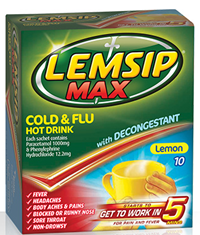Causes and Treatments of a Fever
You can get a mild fever with a cold, but a fever is more commonly associated with the flu. It may also be worse with the flu, with the body temperature sometimes reaching as high as 40°C.
Again there is a good reason why your body is sending its internal temperature rocketing. It's caused by chemicals known as pyrogens which try to kill the infective agents that have entered your system.
Treating a fever associated with a severe cold or the flu
While most fevers are not serious and tend to go away on their own once the illness or infection clears up, they are not pleasant. You can however help yourself by:
- Keeping hydrated – take sips of water regularly
- Cooling your skin down with a tepid flannel
- Taking a pain relieving medicine that can help to bring down your temperature and target some of the other symptoms your body is also trying to cope with. Talk to your pharmacist about what would be most appropriate as they have access to Lemsip products that have pharmacy strength ingredients that you cannot pick up off the shelf.
When to call a doctor
While a fever is a common symptom of severe colds and the flu, you should consult your doctor if you or a child has a very high fever or a recurrent fever, especially if:
- You suspect an underlying infection which may need antibiotic treatment
- It's in a very young child or in a child who becomes unresponsive
- The fever remains higher than 38.5ºC (101.3ºF) even after medication
- A child or adult has a stiff neck, an unusual rash or difficulty breathing
Related Articles

Check out some other articles related to cold and flu symptoms.
